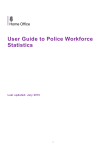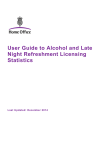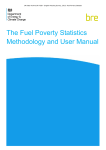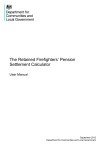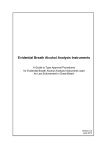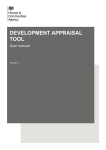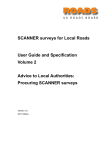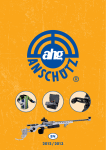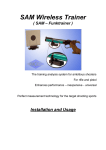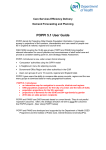Download User Guide to Firearm and Shotgun Certificate Statistics
Transcript
User Guide to Firearm and Shotgun Certificate Statistics Last updated: August 2014 Contents Page 1 Introduction................................................................................................................ 3 2 Glossary ..................................................................................................................... 6 3 Conventions used in firearm and shotgun certificate statistics .......................... 7 4 Legislation and regulations...................................................................................... 8 5 Data coverage…. ....................................................................................................... 11 6 Other sources of information…. .............................................................................. 12 Appendix A: Key stages in the production of the statistical release .................................. 13 1 Introduction Statistics covered The ‘Firearm and Shotgun Certificates in England and Wales’ statistical release presents information on certificates issued by the police under the Firearms Acts 1968 to 1997. It also provides information on the number of registered firearm dealers, visitors’ permits and European firearm passes (EFP) issued. Statistics in the release are presented on a financial-year basis. This means the figures relate to the number of certificates and permits issued on 31 March each year, as well the numbers of applications received, granted or revoked over the 12-month period to 31 March. Quality and methodology The statistical collections covered by this release are by-products of police administrative processes, and form part of the statutory Annual Data Requirement (ADR) between the Home Office and police forces. Key stages of the data collection process are listed in Appendix A. This collection differs from most other ADR collections, in that the data are collected by means of a single snapshot from a national database, the National Firearms Licensing Management System (NFLMS). This has been the case since the financial year ending March 2008; before then the data were collected by means of statistical returns from each force. While the published figures on firearm and shotgun certificates come from the NFLMS, these data originate from the police forces’ certification records and as such the quality and reliability is good. The figures are always subject to the inaccuracies inherent in any large recording system and are not necessarily accurate to the last digit. Any quality deficiencies for a particular year’s data are listed in the ‘Data quality and interpreting the figures’ section of that year’s main release. Uses Statistics on firearm and shotgun certificates are used for a variety of purposes, which are listed in general terms using the standard categorisation for official statistics (as shown in the UK Statistics Authority monitoring brief 6/2010, The Uses Made of Official Statistics). Specific uses over the period in question appear in the main release. Informing the general public’s choices: a) about the state of the economy, society and the environment. Figures on legally held firearms are sometimes used by the media in articles on law and order; b) about the performance of government and public bodies. Figures on levels and trends in firearm and shotgun certification are requested via Parliamentary Questions and Freedom of Information cases to gauge performance in general or specific areas. Government policy making and monitoring: Firearm and shotgun certificate statistics are used to monitor the performance and effectiveness of police forces and government policy. Resource allocation – typically by central and local government: Policing statistics, including firearm and shotgun certificates, demonstrate the range, extent and quality of police activities, and contribute to overall cases for police funding. Informing public marketing campaigns: Firearm/shotgun certificate statistics are rarely used for marketing campaigns. Supporting third sector activity – lobbying: Firearm and shotgun certificate statistics are used by lobby groups to protect the rights and civil liberties of citizens, and to support the value of legally held guns in the farming community, for example. Facilitating academic research: Research into policing and criminology often use police statistics such as workforce and recorded crime, but rarely firearm certificates. Figures for other countries Annual statistics on the number of firearm and shotgun certificates granted, renewed and revoked by the police forces in Scotland are published by the Scottish Government. The figures are considered to be broadly comparable with those for England and Wales, because of the common legislation that governs the certification process. The Police Service of Northern Ireland lists its statistical outputs on the Statistics page of its website, but there are no series that are directly comparable to those for England and Wales. User experiences The timing of the release has been brought forward in response to users’ comments about timeliness, The extraction of data from the NFLMS has enabled the release to be brought forward, and from 2012 it has been published within 5 months of the end of the data period. There have been occasional requests, (for example, Parliamentary Questions or Freedom of Information requests), for extra detail to that published in the release. Figures such as the type of gun certificated have been provided following an additional data extract from NFLMS. Acknowledgements ‘Firearm and Shotgun Certificates in England and Wales’ and the accompanying datasets are prepared by staff in the Policing Statistics team, which is part of the Home Office Statistics Unit of the Home Office Science Group. We would like to thank staff in Home Office Technology (HOT) for the provision of data from the NFLMS database and the firearms licensing managers in the police forces of England and Wales. The editors also thank David Blunt, the Home Office Chief Statistician and Head of Profession for statistics, for his support and guidance during the preparation of this release. Finally, we would also like to thank those colleagues in the Science Information and Publication Team (SIPT) of the Home Office Science Group who assisted in preparing the web pages. Where are the latest published figures? Forthcoming publications are pre-announced on the UK Statistics Authority (UKSA) website. Editions of ‘Firearm and Shotgun Certificates in England and Wales’ and other Home Office statistical releases are available from the Home Office pages of the GOV.UK website. Feedback and enquiries We welcome feedback on ‘Firearm and Shotgun Certificates in England and Wales’. If you have any comments, suggestions or enquiries, please email them to [email protected], complete the online survey or write to: st Home Office Statistics, 1 Floor, Peel Building, 2 Marsham Street, London, SW1P 4DF. ‘Firearm and Shotgun Certificates in England and Wales’ is designated as 'National Statistics', a subset of official statistics that has been granted accreditation by the UK Statistics Authority. National Statistics are produced to high professional standards set out in the Code of Practice and undergo regular quality assurance reviews to ensure that they meet customer needs. They are produced free from political interference. 2 Glossary Article 7 Authority – Article 7 of the Weapons Directive requires any EU resident wanting to purchase certain types of firearms, or ammunition for such firearms, outside their State of residence to have the prior authority of their own State. European firearms pass (EFP) – The European firearms pass (EFP) is a passport for firearms for EU residents intending to take their firearm or shotgun to another EU state. Financial year – The 12 months ending on 31 March. Firearm – According to the Firearms Act 1968, a firearm means a lethal barrelled weapon of any description from which any shot, bullet or other missile can be discharged. It includes any prohibited weapon, any component part of such a weapon and any accessory to such a weapon designed or adapted to diminish the noise or flash caused by the firing of the weapon. It is – with certain statutory exceptions – an offence to possess, purchase, or acquire any firearm or ammunition to which section 1 of the Firearms Act 1968 applies without holding a firearm certificate. Section 1 of the 1968 Act applies to all firearms except a shotgun or an air gun. Government Office Region (GOR) – The Government Office Regions have been the primary classification for the presentation of regional statistics since 1996. GORs closed on 31 March 2011 but the regional level geography has been retained for statistical purposes. The former GORs are now simply referred to as ‘regions’. There are 9 regions in England: North East; North West; Yorkshire and the Humber; East Midlands; West Midlands; East of England; London; South East; South West. Tables in ‘Firearm and Shotgun Certificates in England and Wales’ also include a total for the police forces in Wales. Population figures – Some of the tables in this release use population figures to calculate the numbers of firearms and shotguns per 100,000 population. The population figures used are mid-2012 population estimates provided by the Office for National Statistics. Shotgun – Defined as a smooth-bore gun (not being an air gun) which: (i) has a barrel not less than 24 inches in length and does not have any barrel with a bore exceeding 2 inches in diameter; (ii) either has no magazine or has a non-detachable magazine incapable of holding more than 2 cartridges; and (iii) is not a revolver gun. Other smooth-bore guns may require a firearm certificate. It is – with certain statutory exceptions – an offence for a person to possess, purchase, or acquire any shotgun without holding a shotgun certificate. Visitors’ permit – Visitors’ permits allow visitors to Great Britain to possess a firearm, shotgun or ammunition without holding a firearm or shotgun certificate. Permits are in force for a period not exceeding 12 months. 3 Conventions used in firearm and shotgun certificate statistics Rounding Data are mainly provided unrounded in the data tables of ‘Firearm and Shotgun Certificates, England and Wales’. This is to promote transparency and allow users to exploit the data further. However, caution should be taken when comparing small differences between time periods; while care is taken in collecting and collating all the information obtained, the figures are subject to the inaccuracies inherent in any large recording system and are not necessarily accurate to the last digit. If data are published in a table in a rounded form, the footnotes to that table explain the reasons for doing this. Percentages are rounded to the nearest per cent using the round-half-away-from-zero method. The round-half-away-from-zero method has been used so that in the borderline case where the fraction of the percentage is exactly 0.5, the rounded figure is equal to y + 0.5 if y is positive, and y - 0.5 if y is negative. For example, 23.5% is rounded to 24%, and -23.5% is rounded to -24%. When rounding whole numbers the result is similar; e.g. when rounding to the nearest 100, 1,250 would be reported as 1,300. Where data are rounded, they may not sum to the totals shown, or, in the case of percentages, to 100%, because they have been rounded independently. Use of symbols The following symbols have been used in the tables: .. * Nil or, for percentage changes, that the amount is not reported because the base number is less than 50; Not available; Not applicable. Revisions to data Data for the latest financial year may be revised in due course. It is the authors’ standard practice to incorporate revisions for previous years in the latest release. Substantial revisions to figures presented in earlier editions of ‘Firearm and Shotgun Certificates in England and Wales’ are described in the ‘revisions analysis’ section of the statistical release. The Home Office corrects and revises data in accordance with its statement of compliance with code of practice for official statistics. 4 Legislation and regulations Introduction The ‘Firearm and Shotgun Certificates in England and Wales’ statistical release presents information on certificates issued by the police, number of registered firearm dealers, visitors’ permits and European firearms passes under the Firearms Acts 1968 to 1997. The Guide on Firearms Licensing Law provides consolidated guidance on firearms licensing legislation. This guide is not intended to be a definitive statement of the law, but a cohesive explanation of the often complex area of firearms licensing. Firearm and shotgun licensing All persons acquiring or in possession of a firearm or shotgun must have a certificate issued by the chief police officer of the police force area in which they live, unless they are otherwise exempt. Persons sentenced to any form of custody for a period of 3 years or more are prohibited from possessing firearms for life. Those sentenced to 3 months or more but less than 3 years are subject to a 5-year prohibition from the date of their release. Certain types of weapons (e.g. machine guns) are prohibited under section 5 of the 1968 Act as amended by section 1 of the 1988 Act; their possession can only be authorised by the Secretary of State after careful enquiries by the police. Firearm certificates Firearm certificates are issued for weapons covered by section 1 of the 1968 Firearms Act (as amended), including rifles, muzzle-loading revolvers and shotguns with magazines that are capable of holding more than 2 cartridges. The chief police officer must be satisfied that an applicant has good reason for wanting a weapon, is fit to be entrusted with it, and that the public safety or the peace will not be endangered. The certificate lists the number, type and serial number of each weapon held and any conditions attached (a standard condition is that weapons and ammunition are held in a secure place when not in use). The Firearms (Amendment) Act 1997 banned all firearms with a barrel less than 30 cm in length or with an overall length of less than 60 cm. Certain types of firearms remain exempt, including muzzle-loading guns, firearms used for the humane killing of animals, flare pistols and vintage pistols held as war trophies or collectors’ items. Section 39 of the Anti-Social Behaviour Act 2003 banned air weapons that use, or are designed or adapted for use with, a self-contained gas cartridge system. With effect from 20 January 2004, under section 5(3) of the 1968 Act, such weapons could not be purchased, acquired, manufactured, sold or transferred without the Secretary of State’s authority. The offence of possession was brought into force separately under subsection 4 and came into effect on 30 April 2004. This made provision for existing owners to keep and continue to use their weapons, provided the weapons were added to a firearm certificate (new or variation). Existing owners who did not wish to apply for a certificate were able to hand their weapon into the police for disposal by 30 April 2004. Shotgun certificates Shotgun certificates, covered by section 2 of the 1968 Act and section 2 of the 1988 Act, permit the holder to possess any number of shotguns. These can include pump-action and self-loading weapons that have a magazine that is incapable of holding more than 2 cartridges, but excludes large magazine smooth-bore guns. Apart from the general prohibitions applying to all types of firearm (see introduction above), applications may not be granted or renewed if a chief police officer has reason to believe that the applicant is prohibited by the Firearms Acts from possessing a shotgun or if he/she is satisfied that the applicant does not have a good reason for possessing, purchasing or acquiring one. Nor may applications be granted or renewed unless the chief police officer is satisfied that the applicant can be permitted to possess a shotgun without danger to the public safety or to the peace (section 3 of the 1988 Act). The certificate specifies the description of the shotguns including, if known, the identification numbers of the guns. Firearm and shotgun certificates – renewal cycle On 1 January 1995, the renewal cycle for both firearm and shotgun certificates changed from 3 to 5 years. The Firearms (Period of Certificate) Order 1994 came into effect on 1 January 1995. The Order extends the life of all firearm and shotgun certificates granted or renewed after that date to 5 years. To alter the number and type of weapons held on a firearm certificate, an application for a variation must be made to the chief police officer. The expiry date of a shotgun certificate can be aligned with the holder's firearm certificate (section 11 of the 1988 Act). In 1989, forces began recording the number of weapons for both firearm and shotgun certificates on their computer systems. Firearm dealers Section 13 of the 1988 Act increased the registration period for dealers from 1 to 3 years. The grounds for refusal of new applications for registration were extended and a register of transactions must be retained for at least 5 years. Section 31 of the Violent Crime Reduction Act 2006 required businesses that sell air weapons to register with the police as dealers. The section was brought into place in 2 stages: businesses were able to apply for registration from 6 April 2007 and the offence of not being registered came into effect on 1 October 2007. Visitors’ permits The conditions for exemptions from holding a firearm certificate were revised in sections 15 to 19 of the 1988 Act. Visitors’ permits were introduced allowing the holder to possess a firearm or shotgun without holding a certificate. Permits are in force for a period not exceeding 12 months. Group applications may be made for up to 20 persons (section 17 of the 1988 Act). European firearms passes and Article 7 Authorities Each EU state was required to amend its firearms legislation to meet the requirements of the 1991 EC Weapons Directive. In the UK these changes were made by means of the Firearms Acts (Amendment) Regulations 1992, which made provision for the police to issue 2 new documents to British residents: the European Firearms Pass (EFP) and an Article 7 Authority. The EFP is broadly speaking a passport for firearms. EU residents intending to take their firearm or shotgun to another EU state will need an EFP issued by their State of residence. There is only one criterion for the issue of an EFP to a British resident, that the applicant must possess a valid firearm or shotgun certificate. The EFP does not replace the certificate. Article 7 of the Weapons Directive requires any EU resident wanting to purchase certain types of firearms, or ammunition for such firearms, outside his or her State of residence to have the prior authority of their own State. In England, Wales and Scotland this agreement is at the discretion of the local chief police officer. Firearms cannot be brought into the UK if an individual does not hold an appropriate firearm certificate, even if Article 7 Authority has been granted. . 5 Data coverage Introduction There are 3 series of data measures for both firearm and shotgun certificates. The data on certificates on issue have been collected since 1971, with a break of 12 years before starting again in 1983, since then they have been collected every year. The data collection on new and renewal applications has been running every year since 1983, and the data on the number of firearms and shotguns covered by certificates on issue have been collected every year since 1995. Data quality and interpreting the figures The statistics in this release for years up to and including 2005/06 were compiled by each police force in England and Wales and included in an annual aggregate return to the Home Office. Due to the transition from in-force data collection systems to the NFLMS during 2006, robust data for all measures relating to the 2006/07 financial year, and numbers of weapons and persons covered by certificates for 2007/08, are not available. Available figures for 2007/08 onwards have been extracted from the NFLMS by the Home Office. They are subject to the measurement inaccuracies inherent in any large-scale recording system. On 1 January 1995, the renewal cycle for both firearm and shotgun certificates changed from 3 to 5 years. Therefore it is not appropriate to directly compare year-on-year changes for renewals. So, for example, an individual who was issued a firearm certificate in 1994 would have needed to have renewed 3 years later, in 1997. For certificates issued in 1995, the renewal would not be due until the year 2000. The number of renewal applications granted in the year ending March 2014 was lower than the previous year for both firearm and shotgun certificates, reflecting the same stage in the cycle as the year ending March 2009, showing a 5-year trend. National Firearms Licensing Management System (NFLMS) The NFLMS is a register of all persons who have applied for, or have been granted, a certificate to possess or acquire a firearm or shotgun. It is a web-based national register of all firearm certificate holders and is used by all police forces in England and Wales. It is a live operational system that allows police forces to interrogate the data. The NFLMS updates the Police National Computer with details of individuals who own firearms and/or shotguns and records details of anyone who has been refused a certificate or had one revoked. In addition, the NFLMS maintains information on people, companies and dealers that have requested firearm and/or shotgun certificates. It also holds information on weapons and their history. NFLMS has a configuration parameter which allows forces to set the number of days prior to the expiry of a certificate at which NFLMS will warn them that they need to send a renewal package to the certificate holder. This parameter is set locally, by the force, usually between 56 and 112 days (8-16 weeks). NFLMS has a further configuration parameter which allows forces to set the number of days at which, having already sent a renewal package, and no renewal application having been received, they wish to send a reminder letter to the certificate holder. 6 Other sources of information Introduction Other statistics relating to firearms are published elsewhere by the Home Office and the Office for National Statistics (ONS). Police use of firearms The Home Office publishes annual figures for each police force in England and Wales on numbers of police operations in which firearms were authorised; the numbers of authorised firearms officers; the numbers of operations involving armed response vehicles; and the numbers of incidents where conventional firearms were used by the police. These statistics are not National Statistics. They are released each year in the form of a Ministerial statement and are available in the Police use of firearm statistics pages of GOV.UK. Police use of TASER The Home Office’s Public Order Unit continues to monitor the use of TASER by all police forces, both by specially trained units and firearm officers, and publishes figures on the Use of taser statistics pages of GOV.UK. These are not National Statistics. Focus on: violent crime and sexual offences The ONS publishes annual statistics on crimes involving the use of a firearm in England and Wales in Focus on: violent crime and sexual offences. APPENDIX A: KEY STAGES IN THE PRODUCTION OF ‘FIREARM AND SHOTGUN CERTIFICATES’ A. PREPARATORY WORK Annual Data Requirement (ADR) process (during the 12 months prior to the data period): • consultation with forces and stakeholders; all stakeholders complete a questionnaire to justify the retention (or otherwise) of each of their series. • requests for changes or additions to the ADR considered by the ADR committee (who weigh up the benefits against administrative burden); and • ADR committee decisions for inclusion in final ADR for submission for Home Secretary’s approval. • Review of IT systems (during the 12 months prior to the data period): • incorporate amendments/additions/withdrawals; and • any case for IT work incurring costs to be justified and approved by budget manager. Agree and pre-announce provisional date of publication of statistical bulletin on Office for National Statistics (ONS) publication hub (around 12 months prior to publication). Review content of statistical bulletin and other regular outputs (around 6 months prior to publication), and agree findings with stakeholders. Any substantial reduction in content of statistical release would require a consultation with users. Review and update project plan for new financial year (around 6 months prior to publication): • include all the milestones in this framework, plus deadlines and measures of criticality; • timings to fit in with staffing levels, pressures and relative priorities of each series;. • timings also to fit in with National Statistics pre-announced months of publication, (with no series to be published more than 12 months after data period) and policy demands. B. DATA INPUT AND QUALITY ASSURANCE Forces input case records to the National Firearms Licensing Management System: • Home Office Technology deal with force queries with inputting data; • Policy team deal with all queries about guidance, definitions and firearms licensing legislation; • Output team deal with all other queries about release practices and the code of practice for official statistics. Estimates are sometimes entered for missing data or if a police force cannot provide figures comparable to the previous period (because of a gap in data recording, for example). Validation and variation checks are conducted, these are a combination of automated error checks, and analytical checks. Receipt and input of revised returns following validation check. Production of complete validated dataset according to required standards. Final checks to ensure data of publishable standard, before data confirmation exercise (see below). C. PREPARATION FOR PUBLICATION Prepare publication schedule (at least 3 months before publication). Agree and pre-announce finalised day of publication (around 1 to 3 months before publication). Data confirmation exercise. All police forces are sent their own headline figures that will appear in the publication and asked to provide written confirmation. This is to further reduce the risk in incorrect figures being published, and supports the Home Office in any disagreement with a police force over the figures published for that force. Revised data to be submitted if necessary. Receipt and input of revised data to NFLMS where appropriate following data confirmation exercise. Produce dataset for use in publication. Prepare draft of tables, charts and commentary and circulate to nominated people for quality assurance (this group appears on the pre-release access list) (2 to 4 weeks before publication). Statistics news release and pre-release access sent for preparation of HTML web pages. 24-hour circulation to nominated list of people (including ministers and press office) as shown on pre-release access list. Meet with Home Office colleagues on 24-hour list to discuss content and handling issues. Publication. D. FOLLOW-UP WORK Wash-up meeting on process of publication. Agree actions for next year, and lessons to be learned. Published dataset to be used for Parliamentary Questions, Freedom of Information and other enquiries (until the next publication).













